Jaipur Itinerary For 3 Days – 72 Hours In Jaipur
The most romantic city in India, Jaipur is regarded as the Paris of India.
Known as the Pink City, Jaipur is a mesmerizing destination that captures the essence of Rajasthan’s royal heritage and architectural splendor. In this comprehensive Jaipur itinerary, we will take you on a virtual tour, unveiling the city’s iconic landmarks, hidden gems, and local treasures. So, let’s dive in –
Why Visit Jaipur
The capital of Rajasthan, Jaipur represents the essence of the entire state.
Rajasthan is known for its rich cultural heritage, vibrant traditions, & majestic palaces, and Jaipur encapsulates these elements in a remarkable way. From historical monuments to bustling bazaars and delectable flavors of Rajasthani cuisines to traditional festivals, Jaipur boasts several attractions which not let you get bored.

And the stunning pink-colored buildings provide you a unique view of every corner of the city. Overall this city offers a perfect blend of history, culture, architecture, and culinary delights, providing an unforgettable experience for travelers.
Best Time To Visit?
November to February is the best time to visit Jaipur when the climate becomes pleasant for sightseeing and the temperature don’t go beyond 20 degree Celsius. This is the time when you can see lots of international tourists in Jaipur, especially during Christmas and New Year week.
Many local and international tourist visit Jaipur in December to celebrate Christmas and New Year’s Eve. From 20 Dec to 5 Jan, you can expect high prices of hotels, and transportation.
After winter, monsoon (Mid-July to October) is the second best time to visit Jaipur when the moderate rainfalls make the weather pleasant to enjoy the hilly side of Jaipur. In the rainy season, you can explore the hidden side of Jaipur which is sandwiched between the lush green Aravali mountain range. During this season you can expect a moderate crowd.
How To Reach?
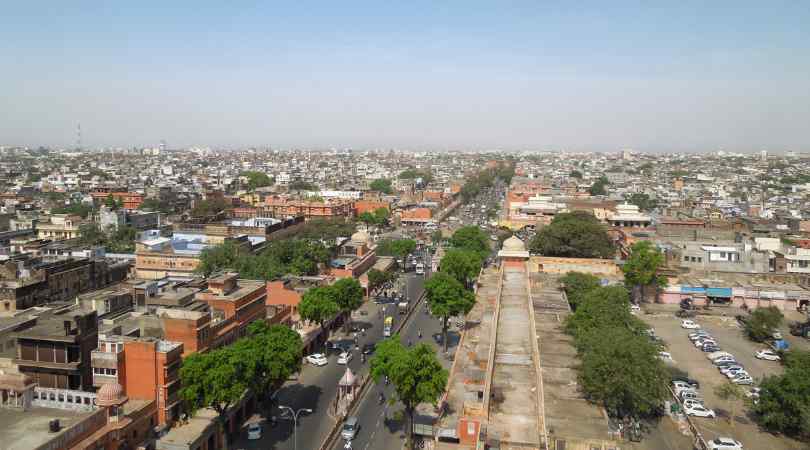
- By Air: Jaipur International Airport (JAI) is located around 13 kilometers from the city center. It is well connected to major cities in India as well as international destinations. Several domestic and international airlines operate regular flights to and from Jaipur. Once you arrive at the airport, you can hire a taxi or take a pre-paid cab to reach your desired location in Jaipur.
- By Train: Jaipur Junction is a major railway station in Rajasthan and is connected to various cities across India. Several express and superfast trains run on regular schedules to Jaipur. Some popular train routes to Jaipur include Delhi-Jaipur, Mumbai-Jaipur, Kolkata-Jaipur, Rewari-Jaipur and Chennai-Jaipur.
- By Road: Jaipur has a well-developed road network, and it can be easily reached by road from nearby cities and states. National Highway 48 (NH 48) connects Jaipur to major cities like Delhi, Mumbai, Ahmedabad, and Agra. You can choose to drive to Jaipur in your own vehicle or hire a taxi or a private car. State-run buses and private buses also operate regular services to Jaipur from various cities in Rajasthan and neighboring states.
- By Bus: Rajasthan State Road Transport Corporation (RSRTC) operates regular bus services to Jaipur from different cities within Rajasthan and other neighboring states. You can opt for both deluxe and semi-deluxe buses depending on your preference and budget. There are also private bus operators offering intercity services to Jaipur.
How To Get Around Jaipur?
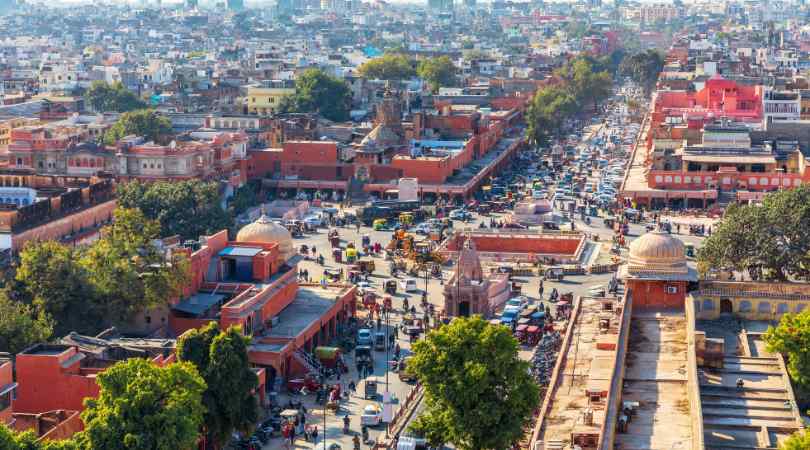
Traffic is something you always get in Jaipur and to get rid of this you need constant transport to get around the city. Jaipur has various modes of transport including cab services, uber-ola, public bus services, rental bikes & cars, auto rickshaws, tuk-tuks, and Rajasthan Tourism Dept. Corp. (RTDC) buses. So, depending on your comfort and budget you can choose the best transport to move around the city.
For family travelers, Uber-Ola could be the best mode of transportation. And for backpackers rental bikes or scooters and tuk-tuk would be good.
Jaipur Itinerary
| Day 1 | Day 2 | Day 3 |
| Morning – Amer Fort including the Diwan-E-Aam, Sheesh Mahal, and breathtaking views from the fort’s ramparts, take an elephant ride – 2 to 3 hours | Birla Mandir | Patrika Gate – for IG pictures Dhani |
| Panna Meena Ka Kund – 900 M from Amer | Jantar Mantar | Galtji Monkey Temple |
| Hanuman Temple HathikundJaigarh Fort | Albert Hall Museum | Sisodia Rani Bagh |
| Sunset at Nahargarh Fort | City Palace & Colorful Bazaar of Jaipur | Chokhi Dhani |
| Late night walk around Jal Mahal | Sunset at Hawa Mahal Movie Night At Raj Mandir Cinema |
Day 1 In Jaipur
Amer Fort
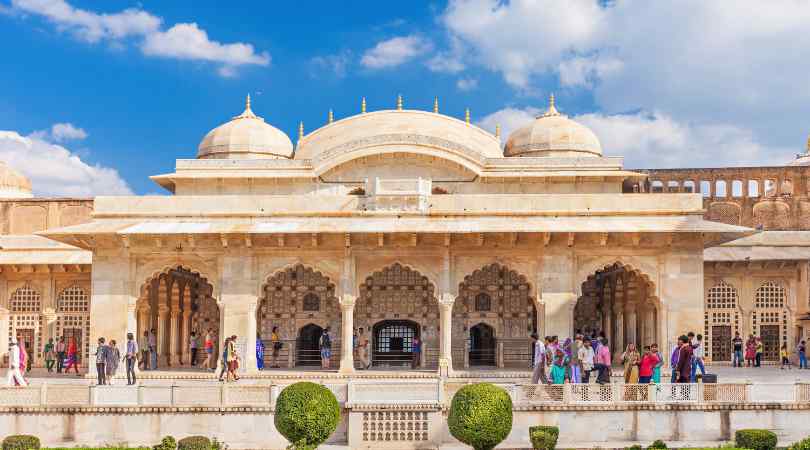
Start your Day 1 in Jaipur early around 7 AM in the morning as today we’re going to explore the magical & historical forts of Jaipur. And Amer Fort will be our first point. Try to reach here around 7:30 to 8 AM as the day progresses the crowd will go up and the sun also start shining brighter.
Amer is the most prominent tourist attraction in Jaipur and your itinerary can’t be complete without visiting it.
Built-in the 16th century by Raja Man Singh, the fort showcases a marvelous blend of Rajput and Mughal architectural styles. It’s grandeur and stunning craftsmanship make it a UNESCO World Heritage Site.
The fort is built on a hilltop, providing panoramic views of Aravalli Hills and Maota Lake. It is made of red sandstone and marble and consists of various sections, including the Diwan-i-Aam, Diwan-i-Khas, Sheesh Mahal, and Sukh Niwas.
Inside the fort complex, you should visit the Sila Devi Temple, dedicated to the goddess Kali.
In the evening, Amer Fort hosts a spectacular sound and light show that narrates the history and legends associated with the fort. The show is presented in both English and Hindi and offers a mesmerizing experience, bringing the fort’s history to life. So, if you visit it in the evening then don’t forget to enjoy this show.
Taking an elephant ride up to the fort entrance is the best thing you can do here.
- Time Needed – 2 to 3 hours
- Timing – 8 AM to 5:30 PM and 6:30 PM to 9:15 PM
- Entry Fee – 100 INR for foreigners and 50 INR for Indian and 10 INR for students
- Light and Sound Show timing – 6:30 PM in English and 7:30 PM in Hindi
Panna Meena Ka Kund – 900 M from Amer
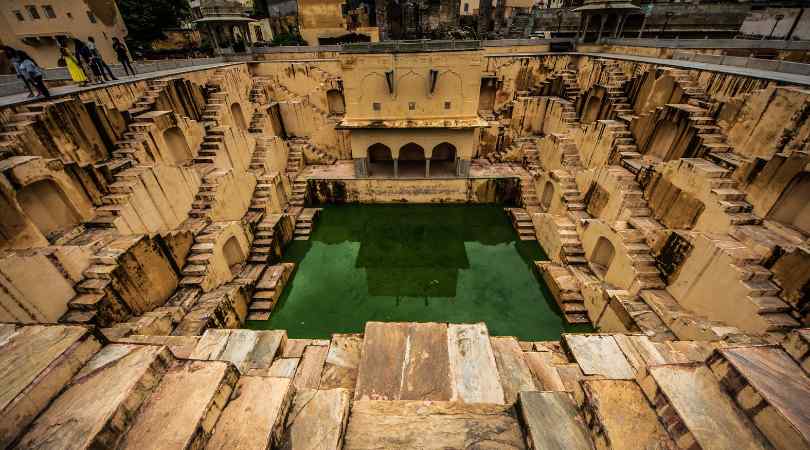
Just 900 meters away from Amer Fort there is your second destination named Panna Meena Ka Kund. This 200 metes deep squared-shaped stepwell is one of the great examples of the magnificent creation of the Indian people.
In the early time when there were no pipelines then people use this to store & utilize rainwater for the dry months. The stepwell has a complex system of underground channels that were used to supply water to the surrounding areas, ensuring a sustainable water source for the community.
The amazing and unique architecture of this place attracts tourists from all over the world. This place is perfect to take IG-worthy pictures.
One of the striking features of Panna Meena Ka Kund is its unique geometric patterns created by the steps. According to locals, you can’t use the same steps to get down and go upstairs.
- Timing – 7 AM to 6 PM
- Entry Fee – Free
Hanuman Temple Hathni Kund
Just 9 KM from Amer Fort and 17 KM from the main city, Hathni Kund is an offbeat place in the lap of nature. Unlike other popular tourist attractions, Hathni Kund is renowned for its amazing views, rich flora & fauna, ancient temples and picturesque trek.
To reach there you need to take a 4 KM trek (both sides) which starts from the Charan temple. It is located on the way to Nahargarh Fort. The trek traverses through the lush green trees, streams, and varieties of flora & fauna.
The best part of this place is the seasonal waterfall which looks surreal in the monsoon. As it is a seasonal place so you can expect the crowd during monsoon. So, while you’re here don’t forget to take a bath under the waterfall.
- Time Needed – 2 to 3 hours
Jaigarh Fort
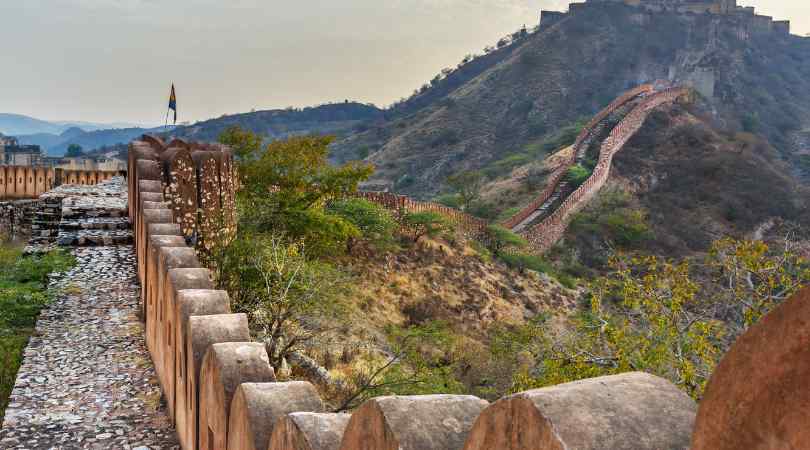
Situated on the top of Cheel Ka Teela or Hill of Eagles, Jaigarh Fort was built in 1726 AD by Jai Singh II. This fort was built to protect the Amer from surprise attacks. And the main highlight of this fort is its underground tunnel which directly connects to Amer Fort.
Surrounded by the Aravali hills, this fort provides scenic views of Maota Lake and Amer Fort. But the main attraction of this fort is the Jaivana Cannon which is known as the world’s largest cannon on the wheels. Also, there is a museum that showcases an impressive collection of weapons, armor, manuscripts, and artifacts that provide insights into the rich cultural heritage of Rajasthan.
- Timing – 9 AM to 5 PM
- Entry Fees – 70 INR per person
Sunset at Nahargarh Fort
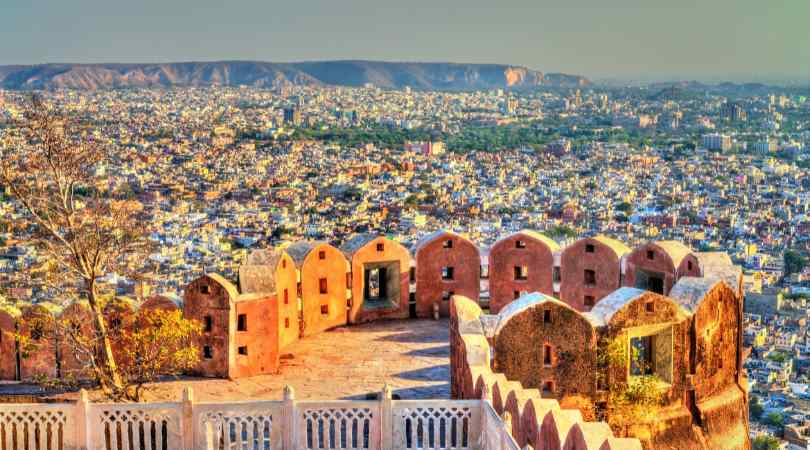
Enjoy the best sunset of Jaipur at Nahargarh Fort.
Perched on the rugged Aravalli hills overlooking the vibrant city of Jaipur, Nahargarh Fort is famous for its rich history, amazing architecture, and panoramic views. Due to its height, the fort offers mesmerizing views of Jaipur city, especially during sunset.
At the time of sunset when the fort gets closed then you can enjoy the sunset from Padao restaurant or from the wall of the fort. Yes, there is a rooftop restaurant that provides amazing food with stunning views of the city. It is one of the most romantic restaurants in Jaipur for dinner.
Just imagine having your favorite food with your loved one and watching the entire city from above, would be a lifetime moment. From the top, you can also catch the panoramic view of the Jal Mahal which looks spectacular during the night.
- Timing – 10 AM to 5:30 PM
- Entry fee – 50 INR
Late night walk around Jal Mahal
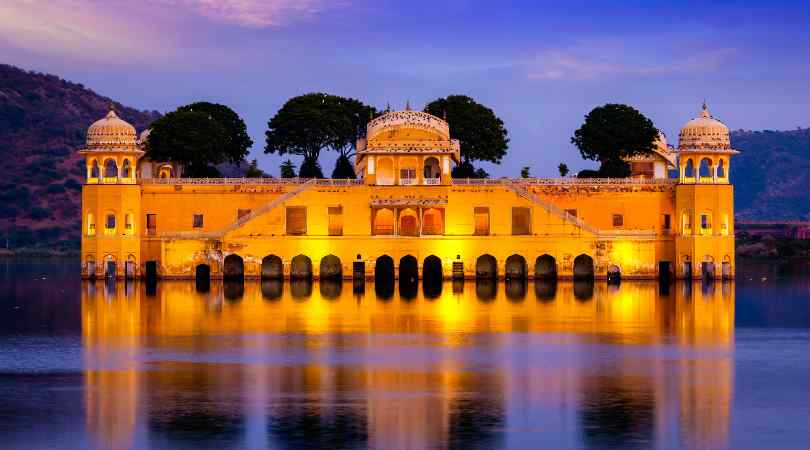
After enjoying the romantic sunset now it’s time to embrace the sparkling beauty of Jal Mahal. Just stop your car around the lake and take a long walk along the edge of the lake with the magical beauty of this architectural splendor.
Day 2 In Jaipur
Birla Mandir
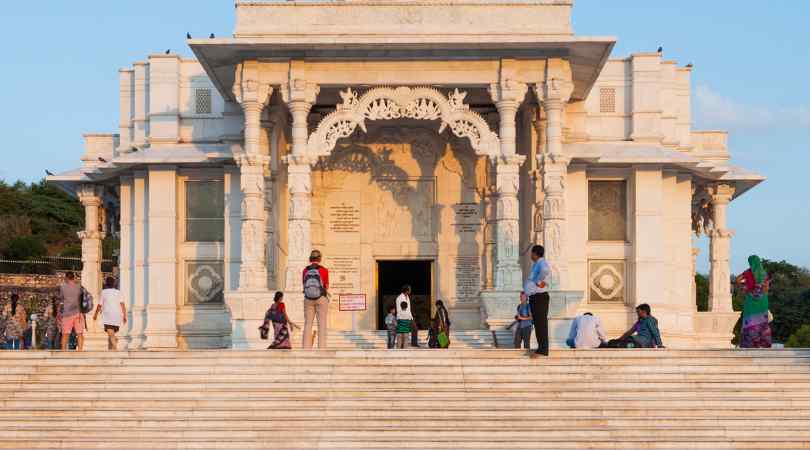
Starts your day 2 in Jaipur with the blessings of Lord Vishnu at Birla Mandir or Laxmi Narayan Temple. Built-in 1988 by B.M Birla this temple is also known as Laxmi Narayan Temple.
The main highlight of this temple is its amazing architecture which is built with white marble. The architecture is the perfect blend of modern and traditional styles. The pillars and walls of the temple are adorned with many mythological figures which depict mythological events like Samundra Manthan, Mahabharata, Ramayana and many more.
The temple celebrates all the cultural and religious events with lots of joy. So, if you’re in Jaipur around Navratri or Diwali then you shouldn’t miss this place.
- Location – Jawahar Lal Nehru Marg, Tilak Nagar, Jaipur
Jantar Mantar
Now it’s time to explore the open-air astronomical observation site that was built around the 18th century. It has a set of 20 large fixed instruments which use for the observation of celestial objects with the naked eye. Each instrument has its own specific purpose but the most popular one is Samrat Yantra which is the largest sundial in the world.
Exploring this architectural masterpiece and its celestial instruments will transport you to an era where astronomy and mathematics played a vital role in understanding the cosmos. Due to that, this place is favorite among scientists.
- Location – Gangori Bazaar, J.D.A. Market, Pink City, Jaipur
- Timing – 9 AM to 4:30 PM
- Entry Fee – 50 INR for Indians and 200 INR for foreigners
Albert Hall Museum
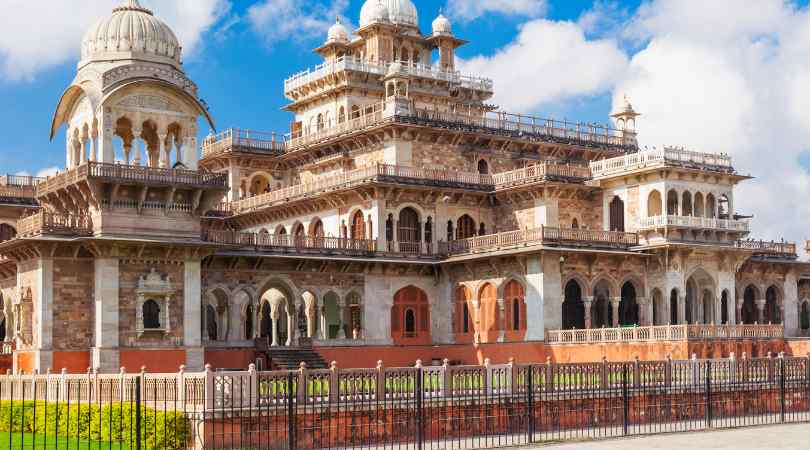
Just 3 KM from Jantar Mantar there is another popular attraction named Albert Hall Museum. It is one of the oldest museums in Jaipur which showcase the grand history of Rajasthan in the form of paintings, sculptures, costumes, books, jewelry, carpets, swords, ivory, and stone.
There you can also see the collections of coins which were used in the era of the Gupta, Mughal and British Empires. The Egyptian Mummy is the most famous part of this museum.
The museum also hosts many exhibitions and events so if you don’t want to miss that then check the museum calendar before visiting.
Along with its historical artifacts, this museum is also known for its amazing architecture which resembles the architecture of the Victoria and Albert Hall museum in London.
- Location – Ram Niwas Garden, Ashok Nagar, Jaipur
- Timing – 9 AM to 5 PM and 7 to 10 PM
- Entry Fee – 40 INR
City Palace
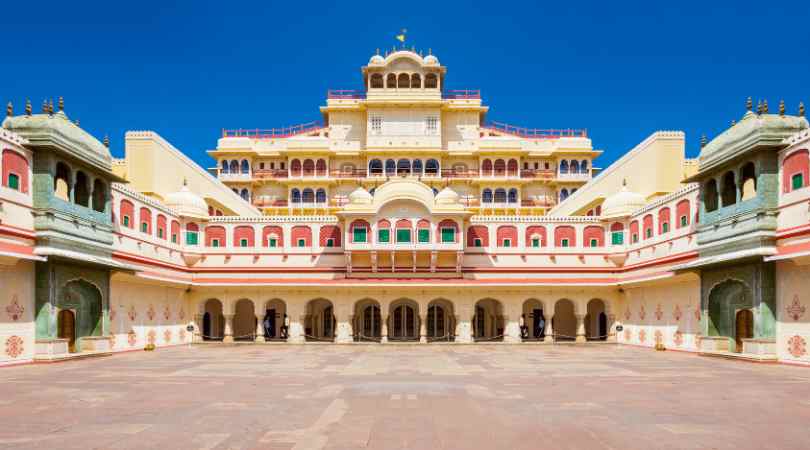
Nestled in the heart of the Pink City, this iconic palace complex is the perfect blend of Mughal and Rajput architecture. This palace was the headquarter of the Royal family of Maharaja Swai Jai Singh II and it still houses the last ruling royal family.
There are different sections in City Palace – Mubarak Mahal is a museum that displays a variety of costumes including royal garments, Kashmiri Pashminas and the dress of Swai Madhosingh I. Chandra Mahal is a 7 storey building where the royal family lives. You can access only the ground floor which has a museum.
Pritam Niwas Chowk, Diwan I Khas, Diwan I Aam, Maharani Palace, Bhaggi Khana and Govind Ji temple are the different-2 sections of City Palace. Each section has its own specialty, some of them are museums and some of them are famous for depicting Indian religious books and sculptures.
The City Palace boasts elegant restaurants and cafes where you can indulge in royal hospitality and savor authentic Rajasthani cuisine.
- Location – Gangori Bazaar, J.D.A market, Pink City
- Timing – 9:30 AM to 7 PM
- Entry Fee – 200 INR for Indians and 700 INR for foreigners.
Colorful Bazaar of Jaipur
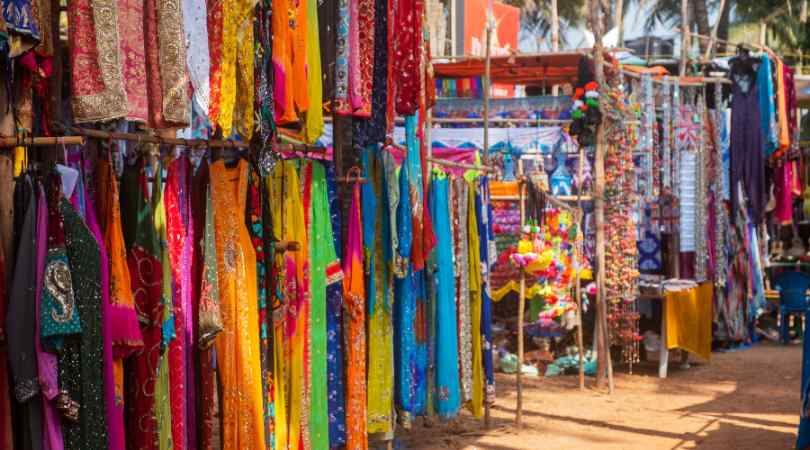
Jaipur is a dream destination for shopaholics. The vibrant streets covered by the historical pink walls look surreal. The bazaars of Jaipur are famous for their traditional handicrafts, textiles, jewelry, and so much more. There are many bazaars but the Pink City bazaar is the most famous one which houses the four main bazaars – Baapu Bazaar, Johari Bazaar, Nehru Bazaar and Kishanpole Bazaar
For jewelry, you should visit the famous Johari Bazaar which is known for the intricate craftsmanship of traditional Kundan, Meenakari, and Polki jewelry.
Baapu Bazaar is famous for high-quality leather-made products textiles, fabrics, and traditional Rajasthani garments. There you will explore the sea of vibrant colors as you browse through a wide array of sarees, lehengas, dupattas, and intricately embroidered fabrics.
Nehru bazaar is known for its traditional and intricately designed footwear while the Kishanpole bazaar is famous for textile and wooden handicrafts that are made by the local artist.
Sunset at Hawa Mahal

Hawal Mahal is the most renowned attraction of Jaipur. The Google search of Jaipur is filled with pictures of this beautiful attraction. It is the perfect place to take some Instagrammable shots, especially at the time of sunset.
It is also known as Wind Palace because it has 950 + windows. These windows are designed to allow the circulation of cool air and provide a vantage point for the royal ladies. It was intended to provide a secluded space for the royal women to observe the bustling street life and processions without being seen.
You can catch beautiful views of Pink City and Jantar Mantar from the top. And if you want to catch the sunset shot then there is a cafe named Wind View Cafe overlooking the Hawa Mahal.
Movie Night At Raj Mandir Cinema
End your day 2 in Jaipur with a movie night at the epic Raj Mandir Cinema of Jaipur. It is one of the largest cinema and older cinema halls in Asia. And it is also one of those which is famous for its epic architecture, designs and interiors.
Day 3 In Jaipur
Patrika Gate – for IG pictures
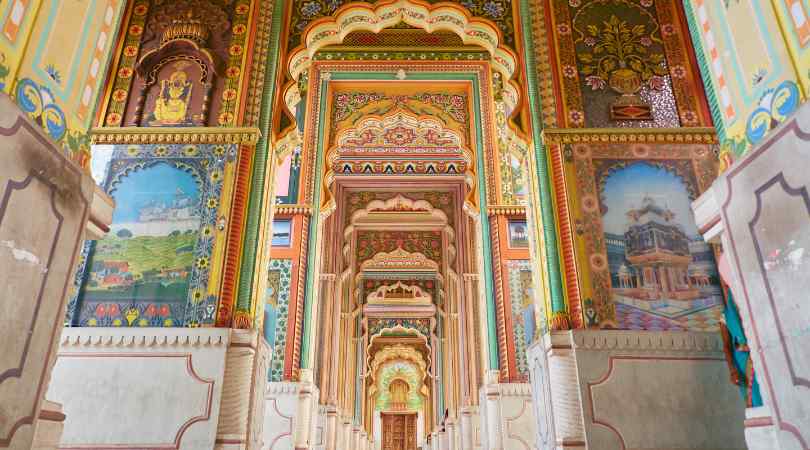
Start your day 3 In Jaipur at the most photographed places in all of India. Located just half an hour away from the main City, Patrika Gate is the main entrance of Jawahar Circle Garden which is the largest circular garden in Asia.
Patrika Gate was built to showcase the rich traditional & cultural heritage of different parts of Rajasthan. Each pillar of Patrika Gate is adorned with paintings and sculptures depicting the famous places of Rajasthan like City Palace, Amer fort, Jal Mahal and many more. Therefore, this place is best to capture amazing insta worthy pictures.
Once you enter the garden you’ll get to see the huge circular garden which is famous for its huge musical fountain show.
Galtaji Monkey Temple
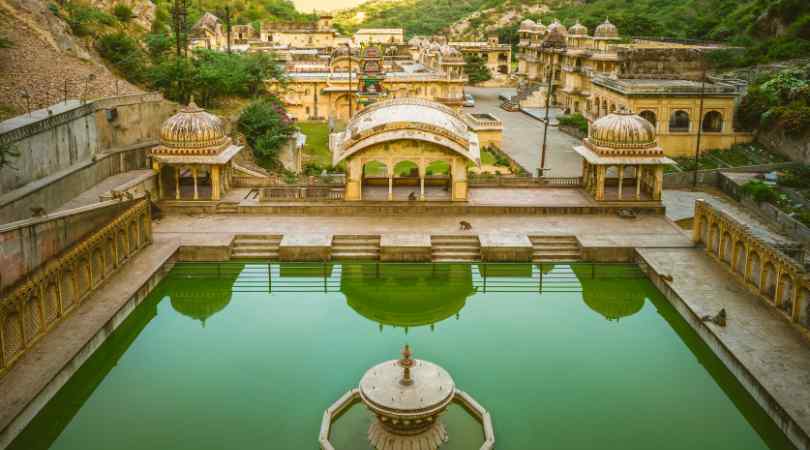
11 KM from Jaipur city, Galtaji temple is a popular Hindu temple. Nestled amidst the picturesque Aravalli hills in Jaipur, the Galtaji Monkey Temple is a hidden gem that offers a unique blend of spirituality, natural beauty, and a close encounter with mischievous monkeys.
The architecture of Galtaji Monkey Temple showcases a beautiful blend of Hindu and Rajasthani architectural styles. The temples are built using pink sandstone, which is characteristic of Jaipur’s traditional architecture.
The temple complex houses more than 200 monkeys therefore it is also known as the Monkey Temple. Also, the complex is home to natural springs which refill the seven large pools. You can take a holy bath in these pools. Among these 7 Kund Galta Kund is the holiest one and it is believed that it never gets dry.
- Location – Shri Galta Peetham, Galva Ashrama Jaipur
- Best time to visit – Monsoon
Sisodia Rani Bagh
Sisodia Rani Bagh is a beautiful garden that showcases the charm of Mughal-style architecture, lush greenery, and a serene ambiance. This enchanting garden was built by Maharaja Sawai Jai Singh II in the 18th century as a token of love for his queen, Rani Sisodia. The architectural style of Sisodia Rani Bagh is heavily influenced by Mughal gardens, characterized by symmetrical designs, ornate pavilions, and beautiful terraces.
Surrounded by lush green hills of the Aravalli mountain range, this place is perfect to spend hours with family & friends. Away from the hustle and bustle of normal city life, this place is perfect for picnic.
- Location – 6 KM from the City
Chokhi Dhani
End your trip to Jaipur with a traditional and local touch of Rajasthan at Chokhi Dhani. Located 14 KM from the main city, Chokhi Dhani is a unique ethnic village resort spread over 12.5 acres of lush gardens. A visit to Chokhi Dhani is like stepping into a bygone era, where you can immerse yourself in the traditional Rajasthani way of life.
Chokhi Dhani is designed as a traditional Rajasthani village, complete with mud huts, thatched roofs, and rustic surroundings. The architecture and ambiance transport you back in time, allowing you to experience the rustic charm of rural Rajasthan.
From traditional folk dances like Ghoomar and Kalbeliya to soul-stirring music performances, every evening at Chokhi Dhani is filled with captivating entertainment.
One of the highlights of visiting Chokhi Dhani is indulging in the delectable Rajasthani cuisine. The resort offers a sumptuous Rajasthani thali, a traditional meal consisting of a variety of mouthwatering dishes.
Things To Know Before Traveling to Jaipur
- Jaipur is one of the most safes places to visit in India so you can visit solo even if you’re a girl. The locals here are very helpful and friendly. But avoid traveling alone at night in deserted places.
- If you’re staying here for a long trip then hire a scooter or bike as it helps you to skip the traffic and save lots of money as well.
- Always do bargaining.
- Don’t hurt local sentiments and political parties. It can lead you to trouble.
Frequently Asked Questions
Are there any day trips or excursions from Jaipur?
Yes, there are several day trips and excursions you can take from Jaipur. Some popular options include visiting the UNESCO World Heritage Site of Jaisalmer, exploring the colorful city of Pushkar, or experiencing the royal heritage of Udaipur.
What are the best places to visit in Jaipur at night?
Jal Mahal, Padao restaurant, Chokhi Dhani, Light & Sound show at Amer fort, Peacock rooftop restaurant, Jawahar Circle garden, Raj Mandir Cinema and Amar Jawan Jyoti.
What are the best options for street food in Jaipur?
Gol gappa, Pyaaz kachori, Lassi, Chaats, Jalebi, Shrikhand, Raj Bhog, Rajasthani Curry, Mangori and Pakodi.